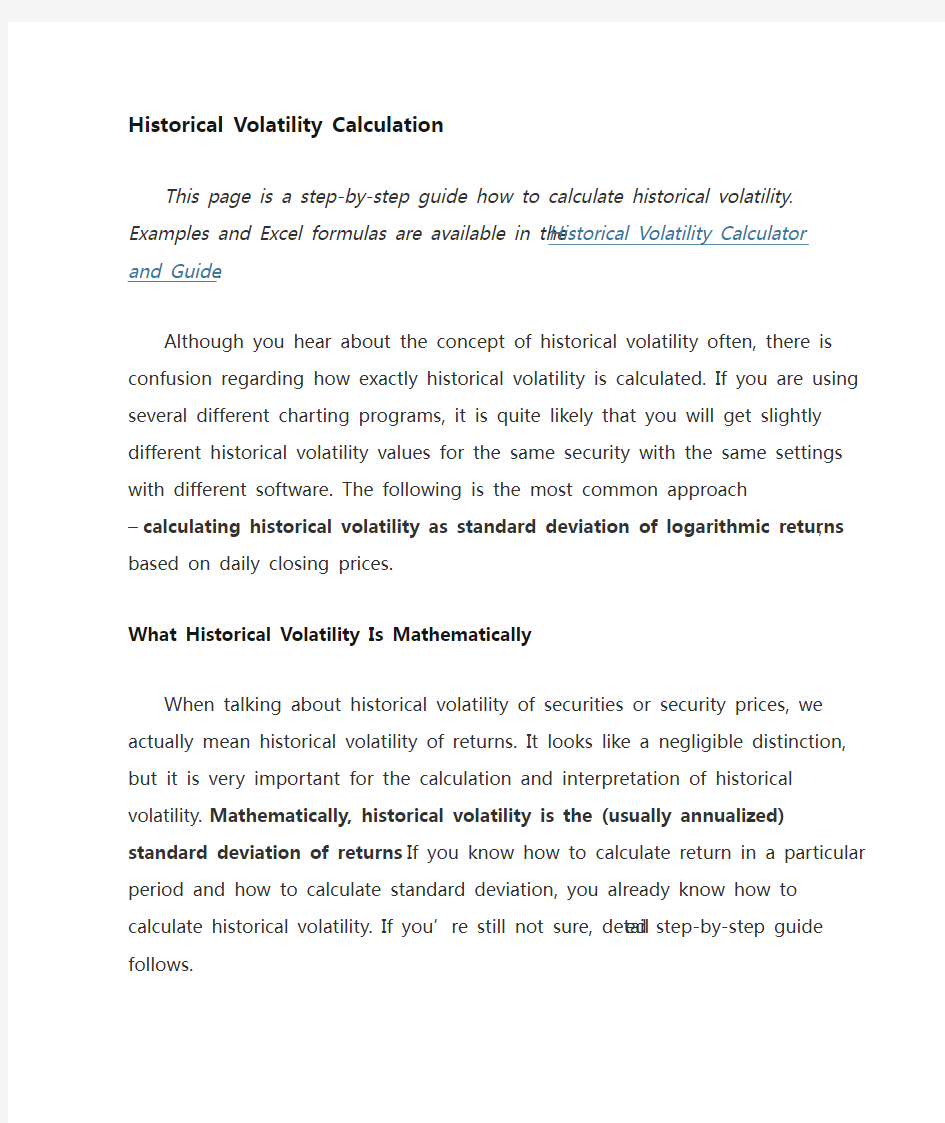历史波动率的计算方法

- 1、下载文档前请自行甄别文档内容的完整性,平台不提供额外的编辑、内容补充、找答案等附加服务。
- 2、"仅部分预览"的文档,不可在线预览部分如存在完整性等问题,可反馈申请退款(可完整预览的文档不适用该条件!)。
- 3、如文档侵犯您的权益,请联系客服反馈,我们会尽快为您处理(人工客服工作时间:9:00-18:30)。
Historical Volatility Calculation This page is a step-by-step guide how to calculate historical volatility. Examples and Excel formulas are available in
the Historical Volatility Calculator and Guide.
Although you hear about the concept of historical volatility often, there is confusion regarding how exactly historical volatility is calculated. If you are using several different charting programs, it is quite likely that you will get slightly different historical volatility values for the same security with the same settings with different software. The following is the most common approach –calculating historical volatility as standard deviation of logarithmic returns, based on daily closing prices.
What Historical Volatility Is Mathematically When talking about historical volatility of securities or security prices, we actually mean historical volatility of returns. It looks like a negligible distinction, but it is very important for the calculation and interpretation of historical volatility. Mathematically, historical volatility is the (usually annualized) standard deviation of returns. If you know how to calculate return in a particular period and how to calculate standard deviation, you already know how to calculate historical volatility. If you’re still not sure, detail ed step-by-step guide follows.
Deciding the Parameters
There are 3 parameters we need to set:
▪The basic period (for which we calculate returns in the beginning) – often 1 day is used
▪How many periods enter the calculation (we’ll refer to this as n) –often 20 or 21 days (the number of trading days and therefore the number of basic periods in one month)
▪How many periods there are in a year (this is used for annualizing volatility in the end)
I mostly use 1 day (day-to-day returns), 21 or 63 days (representing 1 month or 3 months), and 252 (as there are 252 trading days per year on average).
It is not as important whether you use 20 or 21 days, or 252 or 262 days. Much more important is that you use the same parameters consistently, so your results will be comparable.
Step 1: Calculating Returns
First we need to calculate the continuously compounded return of each period. In our case, we will calculate the day-to-day returns for each of the 21 days (our n=21):
ln = natural log
C n = closing price
C n-1 = previous day closing price
Step 2: Standard Deviation of the Returns Next we need to calculate the standard deviation of the returns we got in step 1. Standard deviation is the square root of variance, which is the average squared deviation from the mean (if you are not familiar with it, here you can see a detailed explanation of variance and standard deviation calculation).
First, calculate the average of the returns we got in step 1:
Then, calculate the squared deviation from the average for each of the returns:
Calculate the average of the squared deviations by summing them up and dividing by n-1 (in our case 21 – 1 = 20). We are dividing by n-
1 rather than n, as we are calculating sample standard deviation (we are estimating the standard deviation from a sample – if not familiar, see the difference between population and sample standard deviation).
Note: This is the variance of the returns.
Calculate standard deviation = square root of variance. The whole formula therefore is:
